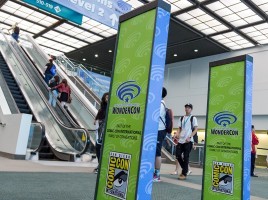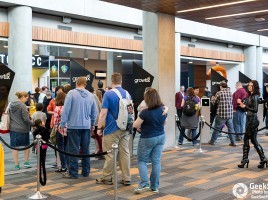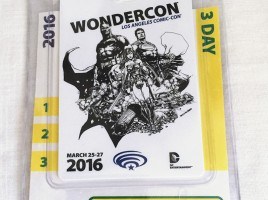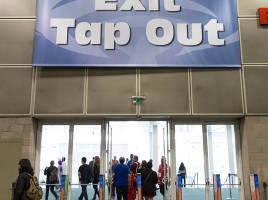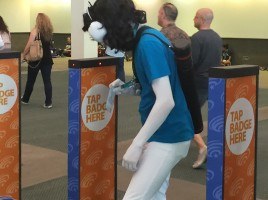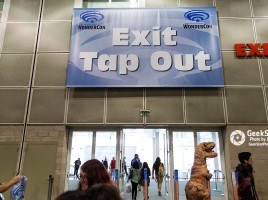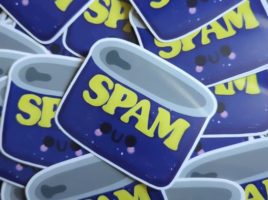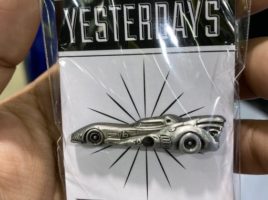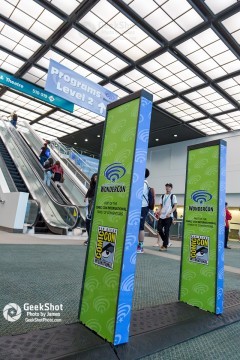
You may have heard that RFID is coming to San Diego Comic-Con this year. Your reaction is probably either “What’s that?” or “Uh Oh!”. Luckily we were at conventions the last two weekends, Silicon Valley Comic Con (SVCC) and CCI’s own WonderCon, and were able to see the technology in use.
Let’s start off with the obvious question, what is RFID? Thanks to wiki we can learn a lot of detail about Radio-Frequency IDentification, but basically it’s the use of electromagnetic fields to automatically identify and track tags attached to objects. You need a tag (wristband, badge, etc.) and a reader/scanner to read the tag. The scanner reading the tag will give a response based on the purpose of using the RFID system, such as whether one has a valid ticket to enter an event. Each tag has a unique identifying number so individual tracking is possible.
Now that we know the basics, let’s go over how RFID was used at both SVCC and WonderCon.
- SVCC had one front (six in/five out) and two side (two in/one out and two in/out) scanning points. This worked since the convention’s exhibit hall and all the panels were in the same building. Once you scanned in you didn’t have to scan out unless you wanted to leave the con. WonderCon had two different areas (West Hall programming and the show floor in South Hall) with multiple access points for each. This meant they had to have scanners set up in a variety of places, which required you to scan in and out as you moved around the con. If you wanted to leave the exhibit hall and see a panel, you scanned out and then back in once you walked down the hall.
- SVCC had wristbands you had to wear all weekend. WonderCon had badges on a lanyard. Both have their pros and cons, but Comic-Con International President John Rogers said at WonderCon Talkback that they tried having exhibitors use wristbands a couple years ago and got a lot of “blowback” so they won’t be using them for RFID.
- Scanning at SVCC was a screen you pressed your wristband against and the staffer read their screen on the other side and gave you the OK to enter. WonderCon used a small monolithic stand with a small light at the top that turned green or red depending on your badge status. It also beeped, but it was the same tone whether the light was green or red.
- Both cons required you to tap in and out — though at WonderCon, you didn’t have to tap out at the largest panel room, the Microsoft Theater, located offsite from the convention center.
Here’s a look at those two different systems:
The use of RFID has been growing at conventions over the last few years, with New York Comic Con and Salt Lake Comic Con being two of the larger cons now using it. Comic-Con International announced they would be using RFID at SDCC back in November and since then we’ve been wondering how it would work and, more importantly, how it would affect attendees.
We asked for thoughts on the RFID at WonderCon and here’s what some on Twitter and Facebook had to say:
https://twitter.com/BrinkerKelly/status/713492439110000640
@SD_Comic_Con I had no problems tapping but the funneling through the sensors was a pain and people didn't have their badges ready to tap
— Jordan B 👻 (@nowhere897) March 28, 2016
https://twitter.com/MissMarie1231/status/714257560484708352
@SD_Comic_Con A big non-issue for me. As long as there are enough "portals" for people to use, not a big deal.
— Shawn Richter @ Our Marvel Wedding (@batcap50) March 28, 2016
@SD_Comic_Con We never had a problem with it this weekend. A little slow at times, but never a big issue.
— Nerds Doing Stuff (@NerdsDoingStuff) March 28, 2016
@SD_Comic_Con If there were no errors and no one in front of me, it was fine! But there was definitely bottlenecking with even a few people.
— Random Penguin (@RandomPenguin) March 28, 2016
@sd_comic_con Could’ve been worse though surprisingly went smoothly. The scans were quick and seemed to organize the entry/exit ways.
— Kiosk (@RantingKiosk) March 28, 2016
https://twitter.com/19Richie79/status/714244958484439041
@SD_Comic_Con Encountering only one sensor hiccup & despite constant stooping, I'm giving them thumbs up if they cut down on fake badges.
— Sonic Nomad (@sonicnomad) March 28, 2016
@SD_Comic_Con it actually seemed to work well for the crowd size. I can't see it running so smoothly for SDCC. Scanners were a biiiit low
— Alex Quevedo (he/him) (@Alex_Quevedo) March 28, 2016
https://twitter.com/LA_Rabbit1/status/714244444996837377
@SD_Comic_Con I liked it, tapping in and out went faster than I thought it would.
— Vanessa ✨ (@fandomnessa) March 28, 2016
@SD_Comic_Con NYCC has had less trouble w/tap in/tap out badges, but it was rough the 1st time too. Def causes slowdowns even when it works
— Anne Kirn⁉️ (@house_of_darkly) March 26, 2016

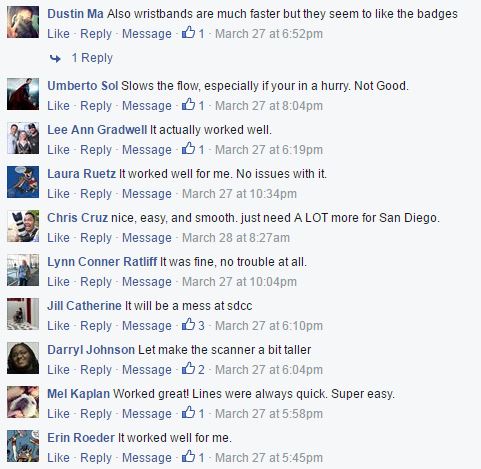


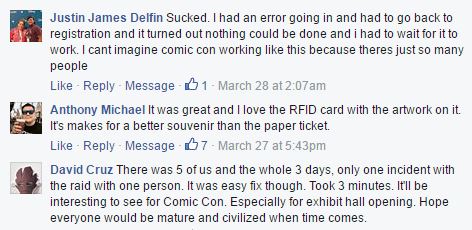
The system obviously garnered a wide variety of reactions. Even people who thought the system worked fine at WonderCon don’t think it would go the same at SDCC.
Will it work the same at San Diego Comic-Con? Will they iron out the bugs? Will it cause huge bottlenecks? Will they raise the scanners?
We’ll have to wait and see on those. But one of the most common questions we can answer is ‘Why even use RFID?’. John Rogers answered that question at WonderCon Talkback, and it’s very simple. They want to stop people using one badge to get multiple people into the con. If each individual has to tap in and out they can’t carry multiple badges back out to another group of friends waiting to get in. Having RFID also means counterfeiters can’t just print up a fake badge and walk in with a visual check from security. A badge to SDCC is highly sought after and CCI wants to protect the experience for those who rightfully paid to attend. RFID gives them a better tool to do so.
Overall, we feel RFID is a positive for Comic-Con. It will cut down on the cheaters and allow for clear entry/exit points of all venues. There will be some problems and bugs since the system is both new and dependent on the technology not breaking down at any point. In order for it to really work though, everyone has to do their part. Attendees need to use the system as intended. CCI needs to listen to feedback from WonderCon and, most importantly, keep the system up and running correctly using whatever means necessary so attendees aren’t negatively impacted.
What are your thoughts on RFID coming to San Diego Comic-Con? Let us know in the comments.




